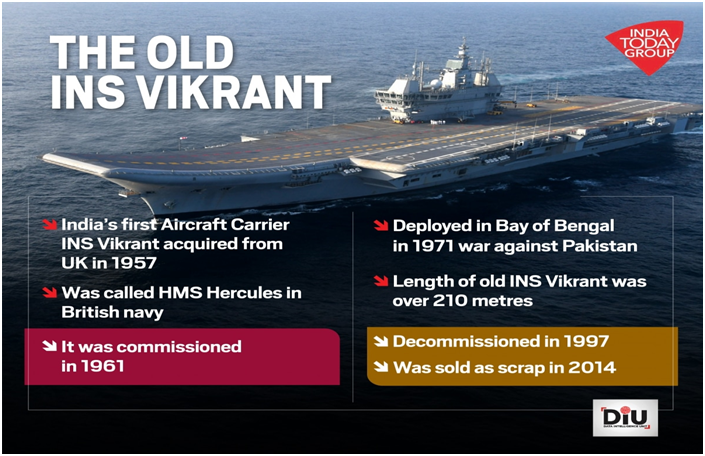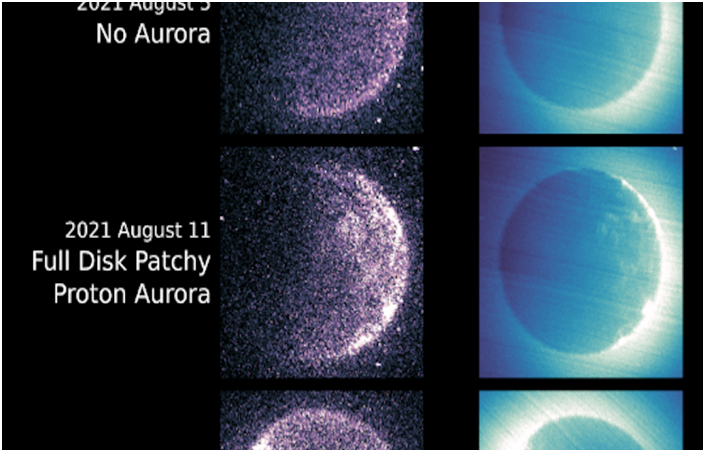Indias first naval aircraft carrier ‘INS Vikrant’ (GS Paper 3, Defence)

Why in news?
- Recently, INS Vikrant, India's first indigenously made aircraft carrier and the largest ship built in the country's maritime history, was commissioned by Prime Minister at Cochin Shipyard Limited in Kerala.
Details:
- The ship, built at a cost of Rs 20,000 crore, has a flying deck that is 262 metres in length and 62.4 meters wide and can make up for two football fields.
- It has been built using indigenous equipment and machinery supplied by India's major industrial houses as well as over 100 MSMEs.
- The new ship has been christened after INS Vikrant or Vikrant (R11), India's first aircraft carrier which was built for the British Royal Navy as HMS Hercules in 1943 and saw action during the India-Pakistan war in 1971.
- About 90 per cent of the hull, 50 per cent of the machinery and 30 per cent of weapons and sensors of INS Vikrant are indigenously designed and built.
- It has been designed by Indian Navy’s in-house Warship Design Bureau (WDB) and built by Cochin Shipyard Limited, a public sector shipyard under the Ministry of Ports, Shipping & Waterways.
Old INS Vikrant:
- India's first aircraft carrier, INS Vikrant, with pennant number R11, was built for the British Royal Navy as HMS (Her Majesty’s Ship) Hercules on October 14, 1943. It was commissioned in the British Royal Navy in 1945.
- After World War II ended, the ship's construction was stopped. It was later sold to India in 1957 in an incomplete condition.
- INS Vikrant underwent a four-year-long refitting at Harland and Wolf Yard in Belfast, Ireland. The ship arrived in India on November 3, 1961 and formally join the Indian Navy fleet in the Bombay Harbour. The commissioning event was attended by then Prime Minister Jawaharlal Nehru amid great fanfare.
- INS Vikrant played a major role in India's decisive victory in the 1971 war with Pakistan. It helped suppress the ground movements and resupply the Pakistani Army in the east by blockading East Pakistan (now Bangladesh) as a whole.
- The ship was decommissioned in 1997 and laid anchored off Mumbai Harbour, serving as a museum.
- In 2013, the central government decided to scrap the ship as it was becoming too expensive for its upkeep. Despite opposition from certain groups, the ship was sold off to Darukhana ship-breaker for Rs 60 crore. The ship was finally scrapped in 2014.
How INS Vikrant is different from its predecessor?
- The new INS Vikrant is 262-metre-long, as against its predecessor which was 192-metre-long. The new ship displaces approximately 43,000 tonnes when fully loaded, as against the former Vikrant which had a full load displacement of 20,000 tonnes.
- The newly commissioned INS Vikrant has a maximum designed speed of 28 knots with endurance of 7500 nautical miles.
- The old INS Vikrant could sail at a speed of 46 km per hour while the new ship can sail at 56 km per hour.
- Besides this, the new INS Vikrant has state-of-the-art features and can operate an air wing consisting of 30 aircraft, including MiG-29K fighter jets, besides the domestically manufactured Advanced Light Helicopters (ALH).
- It has around 2,200 compartments, designed for a crew of around 1,600 that include specialised cabins to accommodate women officers and sailors.
Way Forward:
- It might take another 5-6 months for INS Vikrant to be combat ready with fighter jets carrying out flying sorties and the warship equipped with surface-to-air Barack missiles. The flying trials are likely to start by November and should end by May 2023.
- With the commissioning of INS Vikrant, the Indian Navy will have two aircraft carriers operational simultaneously -- the second one being INS Vikramaditya.
- This would solve the Navy's problem of continuing its naval operations even as the other ship goes in for maintenance.
‘Conversion therapy’ is misconduct, declares National Medical Commission
(GS Paper 2, Governance)
Why in news?
- The National Medical Commission (NMC), the apex regulatory body of medical professionals in India, has said that “conversion therapy” will be counted as professional misconduct.
- It has also written to all the State Medical Councils empowering them to take disciplinary action against medical professionals if they undertake “conversion therapy”.
Background:
- The Madras High Court has directed the National Medical Commission to issue necessary official notification by enlisting – Conversion Therapy as a professional misconduct.
- In compliance of order July 8, 2022, Ethics and Medical Registration Board, National Medical Commission has decided that conversion therapy will constitute a professional misconduct under the Indian Medical Council (Professional Conduct Etiquettes and Ethics) Regulations, 2003.
Reparative therapy:
- The move is a singularly significant step towards eliminating quackery. According to experts “Reparative” or “conversion” therapy is a dangerous practice that targets LGBTQ+ youth and seeks to change their sexual or gender identities.
- So-called “conversion therapy,” is a range of dangerous and discredited practices that falsely claim to change a person’s sexual orientation or gender identity or expression.
- Such practices have been rejected by every mainstream medical and mental health organization for decades, but due to continuing discrimination and societal bias against LGBTQ people, some practitioners continue to conduct conversion therapy.
Minors are especially vulnerable, and conversion therapy can lead to depression, anxiety, drug use, homelessness, and suicide.

What American Academy of Child and Adolescent Psychiatry says about conversion therapy?
- The American Academy of Child and Adolescent Psychiatry has said that it finds no evidence to support the application of any “therapeutic intervention” operating under the premise that a specific sexual orientation, gender identity, and/or gender expression is pathological.
- Furthermore, based on the scientific evidence, the AACAP asserts that such “conversion therapies” (or other interventions imposed with the intent of promoting a particular sexual orientation and/or gender as a preferred outcome) lack scientific credibility and clinical utility.
- Additionally, there is evidence that such interventions are harmful. As a result, “conversion therapies” should not be part of any behavioral health treatment of children and adolescents.”
Emirates Mars Mission discovers new 'patchy' Proton Aurora
(GS Paper 3, Science and Tech)
Why in news?
- Recently, the Emirates Mars Mission (EMM), the first interplanetary exploration undertaken by an Arab nation, has made first observations of a new type of proton aurora around Mars.
Similar to Northern Lights:
- The proton aurora captured on Mars by the Emirati Mars mission are comparable to the aurora that's visible near Earth's North Pole (Northern Lights).
- The Northern lights occur on earth because of the Solar Wind getting attracted by Earth's magnetic field and eventually colliding with atoms in the atmosphere.
How Martian proton aurora is formed?
- This new patchy type of Martian proton aurora is formed when the high-speed solar wind directly impacts Mars’ dayside upper atmosphere and emits ultraviolet light as it slows down.
The discovery of the aurora was made in snapshots of the dayside disk obtained by the Emirates Mars Ultraviolet Spectrometer (EMUS), which observes the planet’s upper atmosphere and exosphere, scanning for variability in atmospheric composition and atmospheric escape to space.

Observations:
- The aurora manifests as bright regions scattered across the dayside of the planet in two ultraviolet wavelengths associated with the Hydrogen atom.
- Under normal conditions, the dayside disk of the planet at these wavelengths is uniform, and the planetary brightness results from Hydrogen atoms scattering sunlight.
- When the aurora occurs, small regions of the planet become much brighter at these wavelengths, signifying intense localized energy deposition in the atmosphere.
- The latest discovery adds a new kind of event to the long list of those currently being studied by EMM and challenges the scientific community's existing views of how the proton aurora on Mars’ dayside are formed.
Initial discovery by MAVEN:
- Martian proton auroras were originally discovered by NASA's MAVEN(Mars Atmosphere and Volatile Evolution) and subsequently found in data from ESA’s Mars Express mission, but most of these previous observations show uniform auroral emission across the dayside of the planet.
- However, the latest observations by UAE's Mars Mission is able to unambiguously reveal small-scale spatial structure.
- Scientists from both teams now believe the patchy aurora can only be produced by plasma turbulence in the space surrounding Mars.
Hope Mission:
- The Emirates Mars Mission is the culmination of a knowledge transfer and development effort that started in 2006. The process saw Emirati engineers working with global partners to develop UAE’s spacecraft design, engineering and manufacturing capabilities.
- Known as 'Hope', the probe is a fully autonomous spacecraft, carrying three instruments to measure Mars’ atmosphere.
- Weighing some 1,350 kg, and approximately the size of a small SUV, the spacecraft was designed and developed by MBRSC engineers working with academic partners, including those at the University of Colorado, Boulder; Arizona State University and the University of California, Berkeley.
- The Emirates Mars Mission is studying the Martian atmosphere and the relationship between the upper layer and lower regions. The Hope Probe’s historic arrival at the Red Planet coincided with a year of celebrations to mark the UAE’s Golden Jubilee in 2021.
Way Forward:
- These new observations, combined with MAVEN data, have lifted the lid on entirely new possibilities for scientific research.
Restructuring Indias cyber infrastructure
(GS Paper 3, Science and Tech)
Context:
- There has been a steady spike in cases of cybercrime in the last five years.
- According to the National Crime Records Bureau (NCRB), from 12,317 cases of cybercrime in 2016, there were 50,035 cases registered in 2020.
- In India, cybercrime is increasing with the increased use of information and communication technology (ICT). However, despite this alarming trend, the capacity of the enforcement agencies to investigate cybercrime remains limited.

Electronic evidence:
- As far as the admissibility of electronic evidence is concerned, though there were some conflicting judgments of the Supreme Court of India earlier, the law was finally settled in Arjun Pandit Rao Khotkar vs Kailash KushanraoGorantyal&Ors.
- The Court held that a certificate under Section 65B(4) of the Indian Evidence (IE) Act was a mandatory pre-requisite for the admissibility of (secondary) electronic record if the original record could not be produced.
Challenges:
- With ‘police’ and ‘public order’ being in the State List, the primary obligation to check crime and create the necessary cyberinfrastructure lies with States.
- At the same time, with the IT Act and major laws being central legislations, the central government is no less responsible to evolve uniform statutory procedures for the enforcement agencies.
- Though the Government of India has taken steps that include the setting up of the Indian Cybercrime Coordination Centre (I4C) under the Ministry of Home Affairs to deal with all types of cybercrime, much needs to be done to plug the infrastructural deficit.
Procedural code for the investigation of cybercrime:
- As electronic evidence is entirely different in nature when compared with evidence of traditional crime, laying down standard and uniform procedures to deal with electronic evidence is essential.
- The broad ‘guidelines for the identification, collection, acquisition and preservation of digital evidence’are given in the Indian Standard IS/ISO/IEC 27037: 2012, issued by the Bureau of Indian Standards (BIS).
- This document is fairly comprehensive and easy to comprehend for both the first responder (who could be an authorised and trained police officer of a police station) as well as the specialist (who has specialised knowledge, skills and the abilities to handle a wide range of technical issues).
- The guidelines, if followed meticulously, may ensure that electronic evidence is neither tampered with nor subject to spoliation during investigation.
Rules for use of digital evidence:
- As resolved in the Conference of the Chief Justices of the High Court in April 2016, a five-judge committee was constituted in July 2018 to frame the draft rules which could serve as a model for the reception of digital evidence by courts.
- The committee, after extensive deliberations with experts, the police and investigation agencies, finalised its report in November 2018, but the suggested Draft Rules for the Reception, Retrieval, Authentication and Preservation of Electronic Records are yet to be given a statutory force.
Shortage of technical staff:
- Second, there have been half-hearted efforts by the States to recruit technical staff for the investigation of cybercrime.
- A regular police officer, with an academic background in the arts, commerce, literature, or management may be unable to understand the nuances of the working of a computer or the Internet.
- He can at best, after proper training, act as a first responder who could identify digital evidence and secure the scene of crime or preserve digital evidence till the arrival of an expert.
- It is only a technically qualified staff who could acquire and analyse digital evidence.
Examples of famous cases:
- The Court, during the trial of the infamous State of Goa, through C.I.D. C.B., North Goa, Goa. vsTarunjitTejpal took objection to the fact that the investigating sub-inspector, who seized the relevant CDs, did not know the meaning of the term ‘hash value’.
- Similarly, in the Aarushi murder case of Noida, reported as Dr. (Smt.) NupurTalwar vs State of U.P. and Anr., the Allahabad High Court observed that the Indian Computer Emergency Response Team (CERT-IN) expert was not provided with the details of the Internet logs, router logs and laptop logs to prove whether the Internet was physically operated on the fateful night.
- Even the certificate under Section 65B of the IE Act (which is statutorily required), was undated, and hence rejected by the trial court.
Cyberpolice station:
- Therefore, it is essential that State governments build up sufficient capacity to deal with cybercrime. It could be done either by setting up a separate cyberpolice station in each district or range, or having technically qualified staff in every police station.
- Further, the Information Technology (IT) Act, 2000 insists that offences registered under the Act should be investigated by a police officer not below the rank of an inspector.
- The fact is that police inspectors are limited in number in districts, and most of the field investigation is done by sub-inspectors. Therefore, it will be pragmatic to consider a suitable amendment in Section 80 of the Act and make sub-inspectors eligible to take up investigation of cybercrimes.
Upgrade cyber labs:
- Third, the cyber forensic laboratories of States must be upgraded with the advent of new technologies. Offences related to crypto-currency remain under-reported as the capacity to solve such crimes remains limited.
- The central government has proposed launching a digital rupee using blockchain technology soon. State enforcement agencies need to be ready for these technologies.
- The Centre helps in upgrading the State laboratories by providing modernisation funds, though the corpus has gradually shrunk over the years.
- While most State cyber labs are sufficiently equipped to analyse hard disks and mobile phones, many are yet to be notified as ‘Examiner of Electronic Evidence’ (by the central government) to enable them to provide expert opinion on electronic records.
- Since there is now a state-of-art National Cyber Forensic Lab and the Cyber Prevention, Awareness and Detection Centre (CyPAD) of the Delhi Police, there may be an extension of professional help to States in getting their labs notified.
Need for data localization:
- Most cybercrimes are trans-national in nature with extra-territorial jurisdiction. The collection of evidence from foreign territories is not only a difficult but also a tardy process. India has extradition treaties and extradition arrangements with 48 and 12 countries, respectively.
- In most social media crimes, except for the prompt blocking of an objectionable website or suspect’s account, other details do not come forth quickly from large IT firms.
- Therefore, ‘data localisation’ must feature in the proposed Personal Data Protection law so that enforcement agencies are able to get timely access to the data of suspected Indian citizens.
- Also, the police still get CyberTipline reports on online Child Sexual Abuse Material (CSAM) from the U.S.’s non-profit agency, the National Center for Missing & Exploited Children (NCMEC).
- It would be a step forward if India develops its in-house capacity and/or makes intermediaries accountable to identify and remove online CSAM for immediate action by the police.
Way Forward:
In fact, the Centre and States must not only work in tandem and frame statutory guidelines to facilitate investigation of cybercrime but also need to commit sufficient funds to develop much-awaited and required cyber infrastructure.





